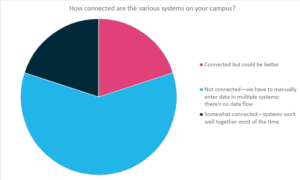Connected ecosystems are the vital next step for institutions to fuel institutional success and bring efficiency and innovation to their administrative teams.
The needs of faculty, staff, and students are continuing to evolve, and there are many different digital tools that can support those needs—but implementing tools is only the first step. Ensuring that those tools connect and form an interoperable system is vital.
In a poll during our recent webinar, 60% of attendees reported that their campus systems were not connected, meaning they have to manually enter data in multiple systems—a huge (and unnecessary) administrative burden.
Experts Natalie Presta, Director of Information Technology at Feather River College, and Kendell Middlebrook, Solution Engineer at PeopleAdmin, broke down the importance of interoperable systems and offered some advice for institutions who are ready to dive in. Read on for some key takeaways!
 What are the main benefits of interoperability?
What are the main benefits of interoperability?
While reduced administrative burden might come to mind first, Natalie Presta broke down the 6 key benefits of interoperability based on her experience in IT.
- Easier scalability
- Your institution’s systems are more agile and capable of growing quickly.
- Cost reduction
- Connected products means that systems can be managed from one central area, reducing the need to spend extra resources/time on monitoring and updates.
- Unified IT architecture
- Not all applications can do all things. With a unified architecture, you can connect applications that can perform disparate tasks and still have all the information centralized.
- When all systems work together, you can meet the unique needs of every department.
- Data security
- Data is an institution’s most vital resource. With connectors, your institution can utilize a more secure SSO system, protecting your information.
- Institution-wide visibility and better decision-making
- Most institutions have a lot of data throughout their applications, but have no efficient way of getting it all out and coordinating it to make strategic decisions.
- Connected systems aid in better communication and data access, decreasing manual processes and human error and increasing the ability to use data for decision-making.
- Interoperability makes it possible to evaluate data in real time across an institution
- Simplified management
- Integrated systems allow us to rely on vendors to do the heavy lifting on the back end, rather than on internal IT teams who may be overburdened.
- Centralized, SSO accessible systems and access also allow for hybrid working or remote working, even with little notice.
 A Changing Landscape in HigherEd
A Changing Landscape in HigherEd
HigherEd has been getting along without interoperability so far—so why do we need to tackle this topic now? Natalie weighed in.
“A lot of us have home grown systems that have helped with the exchange and collection of data–but now we want to analyze it, and a lot of the home-grown systems can’t do that level of analysis or computing. Spreadsheets and flat file don’t do enough. We’re asking our same processes to do more and we’re getting stuck. In some cases, we’re not sure how to expand a system because it was built by a single person who has since left the institution—this type of system isn’t sustainable. HigherEd is at a pivotal point. We’re seeing a data evolution. we’re integrating data and information from all ends of the institution in a way that hasn’t been there before—and that requires solutions we’ve never had before.”
 How to approach the conversation about interoperability
How to approach the conversation about interoperability
One challenge faced by many teams is how to broach the subject of spending more budget to build interoperable systems and connectors. The key to these conversations, says Kendell Middlebrook, is to make sure you have all of the information.
“When you speak to a vendor, start asking questions about budget, cost, and ROI early on. Most vendors—like PeopleAdmin—will work closely with you to find a budget that works for your institution, and can share detailed information about ROI, including time savings, future budget savings, staffing costs, and more. That way, when you go to leadership, you know exactly what you’re working with and you can detail the ROI, explaining to leadership where and how exactly you will be saving budget in the future to justify the spend today.”
Natalie recommends having internal conversations to ensure that you’re asking the right questions about the solutions ROI.
“Look at current pain points on campus, finding out what’s not working and would really make a difference if it was improved. Often, having conversations with IT can help – there might be a technological solution to a persistent problem that your department is dealing with, and your IT team can help you translate that need into tech talk so you can find the answers you need.”
 Getting buy-in
Getting buy-in
Getting buy-in not just from leadership, but from the full campus, can be another barrier. The right way to get buy-in can vary from campus to campus, but there are some key starting points, according to Natalie.
“The best way to communicate really depends on the campus culture and the organization. What works for my campus might not necessarily work for yours, but any time that you can connect the conversation about interoperability to a strategic plan that’s already in place, you should. Strategic plans have pain points that have already be identified as strong needs on campus, so if you can connect your proposal to those pain points, it will help a lot. It’s also important to find your champions: the individuals who are part of a group you’re working with who believe in the same mission and goal as you, and who can then help educate others on why interoperability is important.”
Learn more!
Check out the on-demand webinar, Connecting Your Campus: Interoperability for Institutional Success, for more key insights and learn more about PeopleAdmin’s Marketplace of Connectors.
